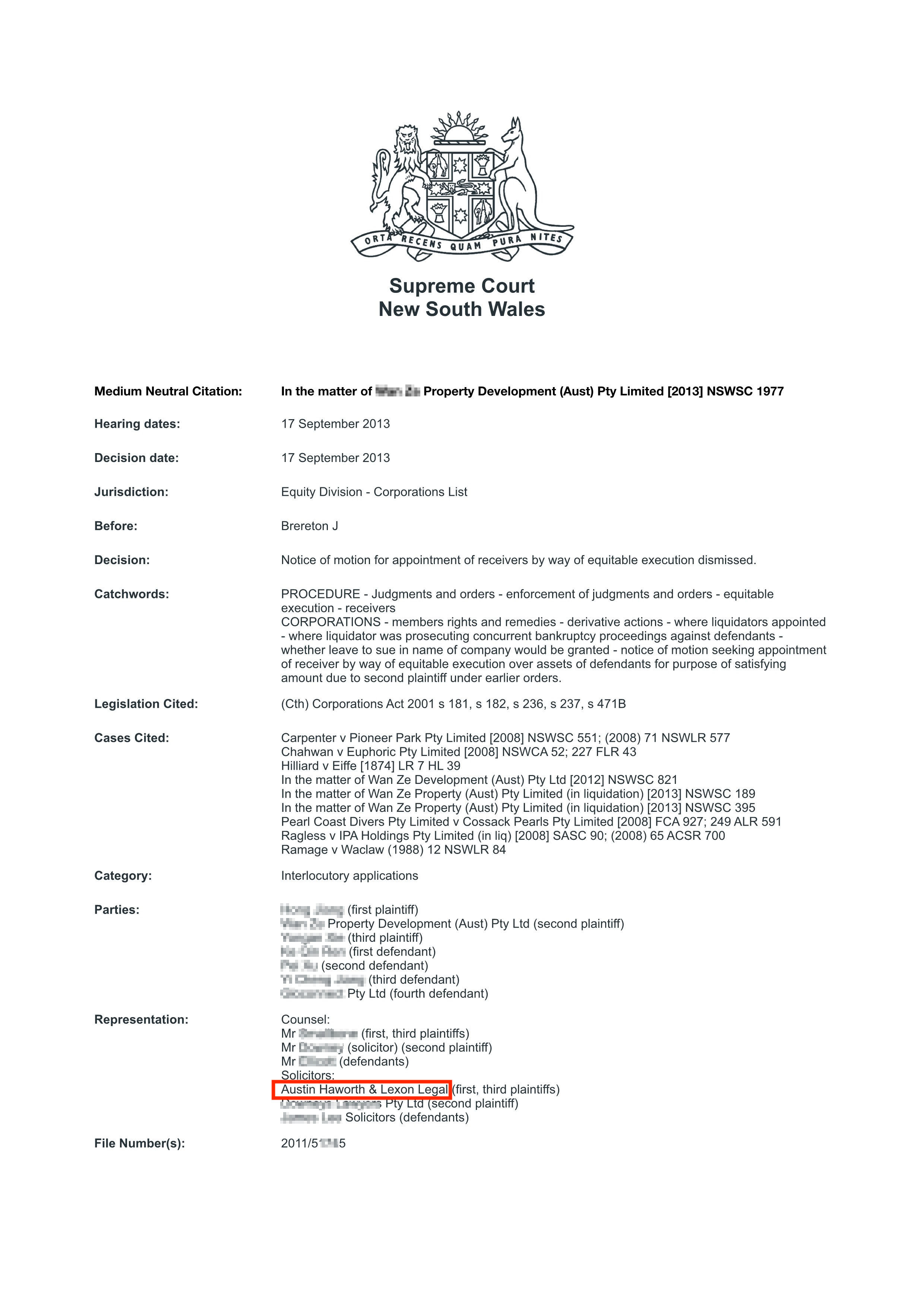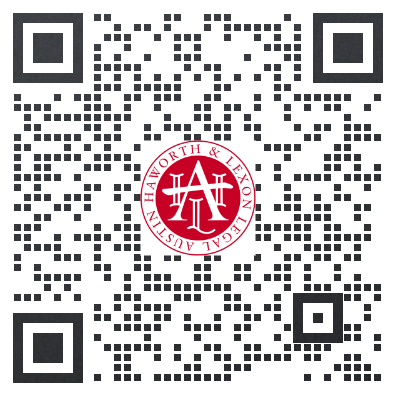【Classic Cases】In the matter of WXX ZX Property Development (Aust) Pty Limited [2013] NSWSC 1XX7

JUDGMENT (EX TEMPORE)
1 HIS HONOUR: On 19 July 2012, Black J gave judgment in the substantive proceedings [In the matter of WXX ZX Development (Aust) Pty Ltd [2012] NSWSC 821] and made orders granting the first plaintiff HXXg JiXXg leave pursuant to (Cth) Corporations Act 2001, s 237 to bring the proceedings on behalf of and in the name of the second plaintiff, WXX ZX Property Development (Australia) Pty Limited, striking out the defendants' defence, declaring that the first and second defendants had contravened s 181 and s 182 of the Act and acted in breach of their fiduciary duties and, most relevantly for present purposes, ordered that the defendants account in common form to the company for all proceeds of sales of property of the company and for all loan proceeds received by the company, for which purpose the matter was referred to an Associate Judge. His Honour further ordered the first and second defendants jointly and severally to pay to the company $2,364,995.70; declared that unit 2X and unit 1X were held on constructive trust by the second defendant and third defendant respectively in favour of the company as sole beneficiary; ordered those defendants respectively to transfer the title to those units to the company and, failing compliance, directed the Registrar to execute all requisite documents to effect such transfer; and ordered that the company be wound up, appointing Mr AnXXXw BaXXXen as liquidator of the company. His Honour also ordered that the defendants pay the plaintiffs' costs of the proceedings on an indemnity basis as agreed or assessed. Those costs have not yet been agreed or assessed.
2 The matter proceeded before Black J as an application for summary judgment, and although a solicitor appeared on behalf of the defendants, the defendants were not present, no evidence was adduced on their behalf and, as I have mentioned, the defences were struck out. The declarations and orders in respect of unit 1X and unit 2X were made on the foundation of allegations that the relevant defendants had procured transfers to them of those units from the company and not paid any consideration before them, notwithstanding that there were forms of contracts that specified sums of consideration. The order for payment of the sum of approximately $2.3 million was made in respect of what were described as "subtractions" by the first and second defendants from the assets of the company.
3 The orders have never been stayed, and no application for a stay has ever been made.
4 The second and third defendants did not comply with the orders for transfer of units 1X and 2X. On 13 August 2012, the Registrar dealt with an application by the liquidator for the Registrar to execute the transfers on their behalf and in their name. The defendants sought to have the matter referred to the Corporations List Judge for the purpose of seeking a stay for 14 days. The Registrar declined that application and proceeded to execute the transfers.
5 On 20 August 2012, the liquidator issued bankruptcy notices, which were served on the first and second defendants on 22 August 2012, claiming the sum of $2,364,995 referred to in Black J's orders.
6 On or about 20 August 2012, a notice of change of solicitor was filed on behalf of the defendants.
7 The defendants filed applications in the Federal Court of Australia on 6 September 2012 to set aside the bankruptcy notices. The plaintiffs observe that no application under s 471B of the Corporations Act was made for leave to bring those proceedings; whether such leave is necessary or not, I do not need to decide.
8 On 2 October 2012, the defendants filed an application in the Corporations List for leave pursuant to s 471B to commence proceedings to set aside the orders made by Black J on the basis that those orders had been procured by fraud and/or bad faith. Then, on 18 October 2012, they filed in the Court of Appeal a summons for leave to appeal from Black J's judgment. Again, the plaintiffs point out that no application for s 471B leave was then made, although one has since been made, but not, at least yet, granted.
9 On 1 November 2012, the liquidator circulated a report to creditors. Significantly, in that report, the liquidator referred to a review conducted by him of the company's bank statements, which enabled him to confirm that the sale proceeds of units 1X and 2X were actually paid to the company. This, seems to me, is potentially a most significant matter, because it demonstrates that the declarations made in respect of those units and the orders for their transfer, since perfected by the Registrar's signature, were prima facie made on a basis that retrospectively can be seen to be seriously flawed.
10 On 21 November 2012, pursuant to a direction made by a Registrar in the Federal Court bankruptcy proceedings, the first and second defendants made and signed statements of their assets and liabilities. The first defendant, KX QXX RXX, declared that as at 13 November 2012 he had a half interest in the family home at North Ryde worth $675,000; a half interest in the furniture worth $15,000; an interest in a joint bank account worth $1,225; 25% of the share capital in GloXXXXect Pty Limited worth $227,890; and a loan to GXX WXX QX in China of 12 million Renminbi, or $1,865,000. His liabilities were said to be a loan secured on the North Ryde home of $409,500; the judgment of $2,364,995; and the costs liability estimated at $80,000. In a note to that statement, he said of GloXXXXect:
GloXXXXect Pty Limited has two shareholders, PXX XX as to 75% and KX QXX RXX as to 25%. The values attributed to those shares in the statements of assets and liabilities have been calculated in the following manner:
GloXXXXect has one bank account which was cash positive at the dates indicated in the statement. GloXXXXect is also the registered proprietor of an unencumbered property at XXX Sutherland Street, Mascot. GloXXXXect also owns two motor vehicles. Those were the only assets of GloXXXXect as at the relevant dates and it had only a hire purchase liability with respect to the motor vehicles as at those dates.
11 The second defendant, PXX XX, in her statement of assets and liabilities declared a half interest in a unit at Macquarie Park, in which she is a tenant in common with a third party which is worth, or said to be worth, $150,000; unit 2X at X2-6X Old Northern Road, Baulkham Hills, said to be worth $560,000, but which was the subject of one of the transfers executed by the Registrar; a half interest in the North Ryde home, said to be worth $675,000; a motor vehicle said to be worth $10,000; jewellery said to be worth $5,000; a half interest in the furniture, said to be worth $15,000; a joint bank account with KX QXX RXX of $1,225; and 75% of the share capital in GloXXXXect, worth $682,179. Her liabilities were the loan on unit 2X of $416,000; the loan on the North Ryde home of $409,500; and the judgment and costs order to which reference has been made. PXX XX's statements of assets and liabilities included a note in respect of GloXXXXect to the same effect as that in Mr RXX's statement.
12 When one extracts from the assets unit 2X, which was, on Black J's orders, beneficially not their property, it becomes apparent that available to satisfy the judgment of $2.36 million was, in substance: their interest in the North Ryde home, worth $1.350 million and subject to a mortgage of $820,000, leaving an equity of $500,000 approximately; their interest in GloXXXXect, worth in total about $900,000; and Mr RXX's interest in the loan to GXX WXX QX of $1.865 million.
13 On 5 December 2012, in connection with the bankruptcy proceedings, each of the first and second defendants proffered to the Federal Court of Australia and to the company in liquidation an undertaking:
Not to remove from Australia or in any way dispose of, deal with, or diminish the value of any of my assets in Australia up to the unencumbered value of $AUS2,374,995. For the purposes of this undertaking, my assets include ... the property known as XXX, North Ryde ... the assets of my businesses and companies in which I have an interest, known as GloXXXXect Pty Limited, MXXXrn CXXXXXXtion Pty Limited and WXXXXrn Property Development Pty Limited, or if any or all of the assets have been sold, the net proceeds of the sale ... This undertaking does not prohibit me from:
(a) paying my ordinary living expenses;
(b) paying my reasonable legal expenses;
(c) dealing with or disposing of any of my assets in the ordinary and proper course of my business, including paying business expenses, bona fide and properly incurred.
14 The defendant's application for s 471B leave to bring proceedings to have Black J's orders set aside for fraud or bad faith was heard by Black J on 14 and 15 February 2013. Judgment was delivered dismissing the application on 13 March 2013 [In the matter of WXX ZX Property (Aust) Pty Limited (in liquidation) [2013] NSWSC 189]. On 19 April 2013, his Honour delivered a further judgment and made an order that the present defendants pay the present plaintiffs' costs of those proceedings. Again, those costs have not yet been assessed [In the matter of WXX ZX Property (Aust) Pty Limited (in liquidation)[2013] NSWSC 395].
15 On 26 April 2013, a motion brought by the present plaintiffs in the Court of Appeal for security for costs of the appeal was dealt with by Basten JA. His Honour ordered that the first and second defendants pay into court the sum of $16,000 by way of security in respect of the costs of opposing the application for s 471B leave, and noted an agreement of the parties, without admission, that upon condition that Mr RXX receive $500,000 from Mr GXX by 5 August 2013, he would notify the present plaintiffs of receipt of those funds pursuant to the undertaking he had given to the Federal Court, pay into this court the sum of $450,000 within 14 days after it was received (to be held pending the outcome of all appeals from Black J's decisions), and pay into court the further sum of $50,000 by way of security for costs of the appeals and associated proceedings. In the event that the sum of $500,000 was not received from Mr GXX by 5 August, then the motion for security was to be relisted on 26 August 2013.
16 As it transpired, none of the money was forthcoming from Mr GXX. Various explanations have been proffered for that. The defendants say, in effect, that Mr GXX was deterred by a phone call that he received from the plaintiffs' solicitor. The plaintiffs deny that there was any such phone call. It is neither possible nor necessary to resolve that dispute on the present application.
17 On 14 May 2013, orders were made in the Federal Court extending time for compliance with the bankruptcy notices - time for compliance with which, I infer, must previously have been extended up to that date - to 23 May, and noting that the undertakings of 5 December 2012, to which I have referred, were extended to 5 December 2013. On 23 May 2013, time for compliance with the bankruptcy notices was further extended to 2 August 2013, and the proceedings were set down for hearing with a three day estimate commencing on 31 July 2013. An application by the present plaintiffs for orders that the defendants give security for $1.6 million, being an amount corresponding with the GXX debt, was dismissed; save to the extent that the defendants were required to give security for $30,000.
18 On 18 June 2013, the defendants filed an application in the Court of Appeal for leave to appeal against Black J's judgments of 13 March 2013 (dismissing their s 471B application), and 19 April 2013 (in respect of costs). No application for s 471B leave was made at that time; but such an application has since been made, though not yet granted.
19 On 4 July 2013, pursuant to arrangements made between the liquidator and the defendants, caveats were lodged by the liquidator in respect of the North Ryde home and the Macquarie Park unit.
20 At some stage prior to 31 July, the three day fixture in the Federal Court, appointed to commence on that day, was vacated and the bankruptcy applications are now listed for hearing for five days commencing on 18 October 2013. I infer that the time for compliance with the bankruptcy notices has been extended, up to the conclusion of that hearing.
21 Late in August 2013, it came to the notice of the plaintiffs' solicitors that the Mascot property of GloXXXXect had been sold. On 27 August 2013, they requested particulars of that transaction from the defendants' solicitors, who on 28 August 2013 provided a copy of the settlement sheet, from which it appeared that the sale had been completed on 31 July 2013 at a gross price of $800,000 and that, from the proceeds, $313,716 had been paid to the Australian Taxation Office, $156,664 to NXXds ChXX and MoXXXan, solicitors, and $286,271 to GloXXXXect. The covering letter advised that the balance of the deposit, after deduction of the agent's commission, was also paid to GloXXXXect.
22 Faced with this information, the plaintiffs' solicitors made further enquiries as to the application of funds. It transpires that the payment to NXXds ChXX and MoXXXan was of a sum of money payable to caveators claiming an interest in the proceeds of the transaction. Of course, there had been no reference to any such liability in the statements of assets and liabilities to which I have earlier referred, nor had there been any reference to any liability to the Australian Taxation Office.
23 On 30 August 2013, the plaintiffs approached the Court ex parte and obtained the following orders:
1. The first, second and fourth defendants be restrained from by themselves their servants or agents causing permitting or suffering GloXXXXect Pty ACN 106 XX7 7X0 to alienate encumber further encumber or otherwise adversely deal with any of its assets or undertaking or incurring any liability, and from causing permitting or suffering GloXXXXect Pty Ltd to take any step in proceedings in any court, other than in these proceedings and in proceedings 2012/ 24XX05 and 2013/ 93XX3 for the purposes of the listing before the Court of Appeal on 2 September 2013.
2. The first, second and fourth defendants do all things necessary or convenient to cause the fourth defendant to pay into court to the credit of these proceedings by 4.00 pm Monday 2 September 2013 all funds under its control, including any funds standing to its credit in any financial institution and without limiting the generality of the foregoing all remaining proceeds of sale of the property at XXX Sutherland Street, Mascot, NSW.
24 When the matter returned before the Court on 3 September, the Court was informed that it had not been possible to pay the balance of the proceeds of the Mascot property into Court because of confusion on the part of Westpac at the impact of the orders. Further orders were made on that occasion in the following terms:
1. The first, second and fourth defendants be restrained from by themselves their servants or agents causing permitting or suffering GloXXXXect Pty ACN 106 XXX 7X0 to alienate encumber further encumber or otherwise adversely deal with any of its assets or undertaking or incurring any liability, and from causing permitting or suffering GloXXXXect Pty Ltd to take any step in proceedings in any court, other than in these proceedings and in proceedings 2012/ 24XX05 and 2013/ 93XX3. This order does not prohibit a payment in conformity with Order 2.
2. The first, second and fourth defendants do all things necessary or convenient to cause the fourth defendant to pay into court to the credit of these proceedings by 4.00 pm Thursday 5 September 2013 all funds under its control, including any funds standing to its credit in any financial institution and without limiting the generality of the foregoing all remaining proceeds of sale of the property at XXX Sutherland Street, Mascot, NSW.
25 The matter returned before the Court on 9 September 2013, when the Court was informed that a sum of about $600 had been paid into Court, the balance between that and $280,000 having apparently been expended on "legal expenses".
26 Ultimately, in Mr RXX's affidavit of 13 September 2013, it was disclosed that between 31 July and 29 August payments totalling $234,589.48 were made out of the funds received by GloXXXXect to JiXXg RXX, the daughter of the defendants, all but $6,000 of which was to reimburse her for moneys advanced by her in payment at earlier dates of the defendants' legal expenses, and the remaining $6,000 being repayment of cash loans. A further $42,224.24 was paid on 6 August 2013 by GloXXXXect to XX WXXg, a nephew of the second defendant, who has resided at her home for the last three years, in reimbursement of an advance of the same amount said to have been paid by him to the defendants' solicitors on 9 January 2013.
27 In that context, the plaintiffs amended their Notice of Motion to seek the appointment of a receiver, to effectively sequestrate all of the assets of the first and second defendants, by way of equitable execution.
28 The first question to which I turn is the standing of the plaintiffs.
29 The first and third plaintiffs, who make the application, are not judgment creditors of the defendants. While there are costs orders in their favour, those costs orders have not yet been assessed, and there is not yet any presently enforceable obligation in that respect. The order for payment of $2.3 million is an order in favour of the company, WXX ZX, now in liquidation, which is under the control of its liquidator.
30 The plaintiffs submit that they have standing to make the application on the basis of the Court's inherent jurisdiction to allow a contributory to bring proceedings on behalf of a company in liquidation.
31 Although it is clear that the statutory derivative action under the Corporations Act s 236 and s 237 is not available in respect of a company once a liquidator has been appointed [Chahwan v Euphoric Pty Limited [2008] NSWCA 52; 227 FLR 43] it is now well-established that that does not affect the inherent jurisdiction in which a contributory or creditor of a company in liquidation may, with the Court's leave, sue in the name of the company [Chahwan v Euphoric; Ragless v IPA Holdings Pty Limited (in liq) [2008] SASC 90; (2008) 65 ACSR 700, Carpenter v Pioneer Park Pty Limited [2008] NSWSC 551; (2008) 71 NSWLR 577; and Pearl Coast Divers Pty Limited v Cossack Pearls Pty Limited [2008] FCA 927; 249 ALR 591].
32 The jurisdiction to grant leave in such circumstances was examined by Barrett J in Carpenter v Pioneer Park, which is now generally taken to be an authoritative statement of the position. It is first to be observed that the jurisdiction is one that is dependent upon the grant of leave by the Court and that, in deciding whether to authorise such proceedings, the Court must take into account a number of issues. Chiefly those issues are whether the proceedings proposed to be pursued have some solid foundation and exhibit such a degree of merit as to be neither vexatious nor oppressive and to present reasonable prospects of success; secondly, the attitude of the liquidator to the question of whether the proceedings should be pursued; and, thirdly, the question whether practical considerations support the initiation of the proceedings, with particular reference to financial protection of the liquidator and the estate of the company by means of indemnity and, if indicated, security.
33 The present proceedings face a number of difficulties in this respect. The first is that they have been instituted without leave and no application for leave has been made within them, let alone has leave been granted. Secondly, the cases refer to the jurisdiction being exercised in special circumstances on the footing that it is ordinarily the liquidator who decides what rights and remedies should or should not be pursued on behalf of a company in liquidation [Ramage v Waclaw (1988) 12 NSWLR 84, 93; Hilliard v Eiffe [1874] LR 7 HL 39, 44; Carpenter v Pioneer Park (supra), [25]]. In this case, the liquidator has stated that he neither supports nor opposes the relief sought. That is in circumstances, however, where the liquidator has, himself, commenced bankruptcy proceedings and entered into arrangements with the defendants in respect of the interim regime while those proceedings are being resolved. Ultimately, if the liquidator succeeds in the bankruptcy proceedings, the estate of the defendants will be sequestrated and a trustee will be appointed of all of their assets. That is, from a practical perspective, almost indistinguishable from the result that will obtain if the Court were to accede to the plaintiff's application, which is the appointment of a receiver of effectively all of the defendants' assets.
34 Both in the Court of Appeal and in the Federal Court, arrangements have been entered into in respect of the interim regime. I do not doubt for a moment that what has happened in respect of the GloXXXXect sale, not unreasonably, occasions the plaintiffs' enormous doubt as to the efficacy of those arrangements; nonetheless, where the liquidator is taking steps to enforce the judgment, where there is no suggestion that the liquidator will not take appropriate steps to do so, where there is no evidence that the liquidator has been requested to do more but has declined to do so, it seems to me undesirable in the extreme that there be two parties attempting to enforce the same judgment for the benefit of one of them. I cannot see, in the context of this case, the type of special circumstances referred to in the cases that I have mentioned, that would justify a grant of leave, if it were sought, to the plaintiffs to prosecute these proceedings on behalf of the company in liquidation. It seems to me that, as things stand, that is peculiarly a matter for the liquidator and not for the present plaintiffs.
35 Other considerations, which support the same conclusion, are that, as I have said, bankruptcy proceedings are on foot which, if ultimately successful, will result in practically the same outcome. In those circumstances, it is difficult to see why resort should be had to the extraordinary remedy of equitable execution, by way of appointment of a receiver, when the bankruptcy jurisdiction has been invoked and provides a practically identical remedy.
36 It is also of importance that the Federal Court dismissed an application for security for the amount of the GXX debt and required security for only $30,000. The present application, in a sense, sits uncomfortably with the regime thus established in the Federal Court pending the determination of the proceedings there.
37 I have also taken into account that, having regard to what I have said about the position with apparent payment for units 1X and 2X and the (prima facie) limited service that the defendants received from their legal representative at the hearing before Black J, it cannot be said that their appeal from his Honour's judgment is unarguable. Moreover, with the exception of the GXX debt, the assets that could be available for execution or in bankruptcy are protected by caveats, and by the injunction that I have previously pronounced and which I propose to continue.
38 Nothing I have said should be taken by the defendants as the slightest comfort in respect of the manner in which they have dealt with the proceeds of the GloXXXXect transaction. It will be for another Court to decide whether that amounted or not to a contempt of Court, but one can hardly be surprised that the plaintiffs would be outraged, not without cause, at the dissipation of what was represented to them to be worth $1 million to effectively nothing. Nonetheless, for the foregoing reasons, it seems to me that the application for equitable execution should not succeed.
THE COURT ORDERS THAT:
(1)Order 1 made on 9 September and continued on 16 September 2013 continue until the hearing of the appeal or further order, subject to the variation of order 1(d) by deleting the matter $5,000 and substituting $2,500 per week.
(2)The Notice of Motion be otherwise dismissed.
39 On the one hand, the defendants have substantially succeeded on the motion, although the plaintiffs have secured a significant improvement in the protection of their position. On the other, there is great force in the argument that the necessity for the application was brought about by, what can only be described as very highly provocative behaviour on the part of the defendants. In those circumstances, I think the proper outcome is that there be no order as to the costs of the motion, save that I order that the liquidator not be entitled to costs or remuneration in respect of or associated with the motion.
40 These orders may be entered forthwith.
**********



 1300 91 66 77
1300 91 66 77







 HOME
HOME


